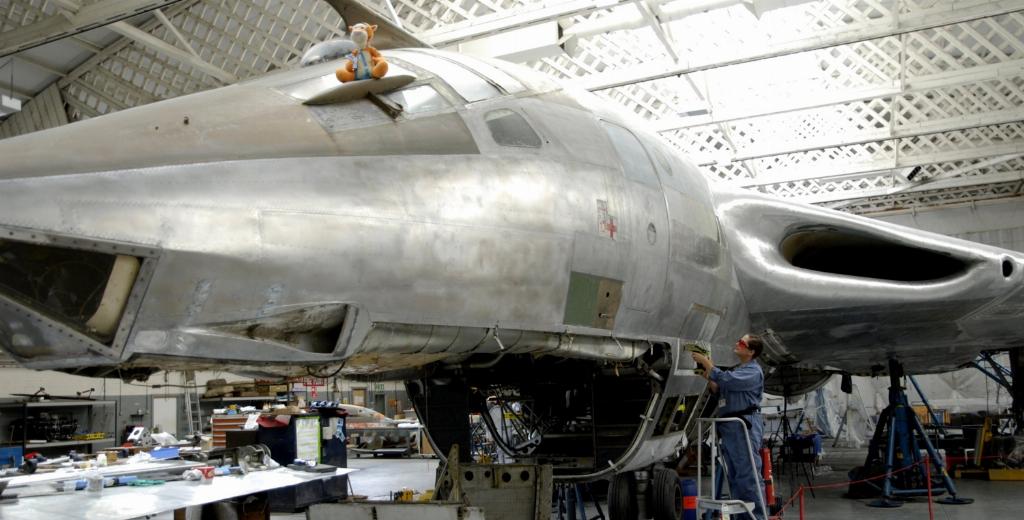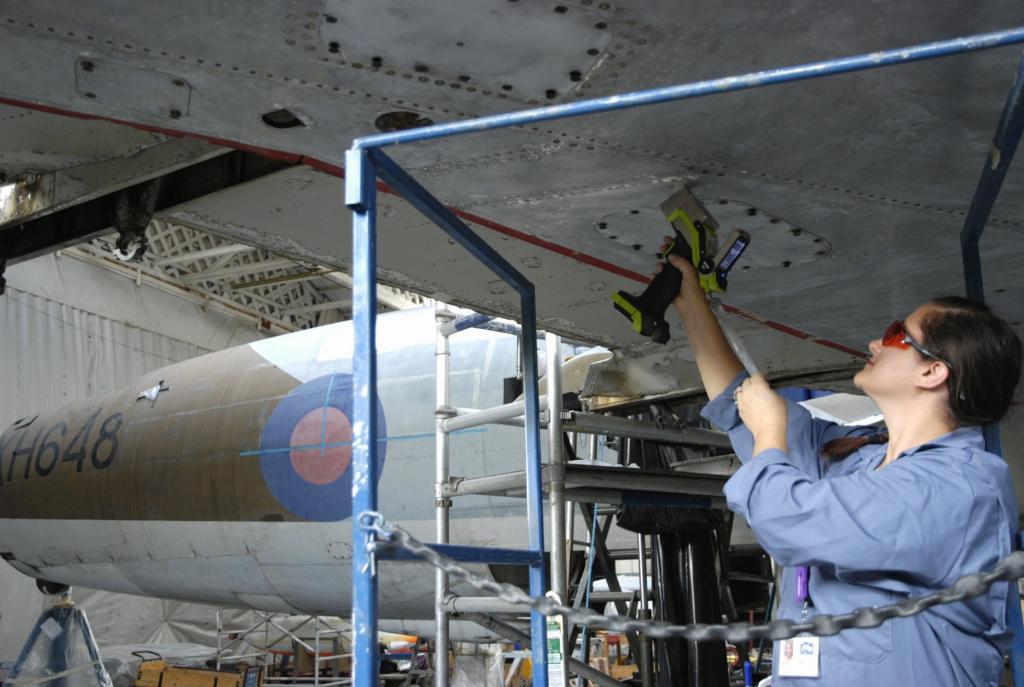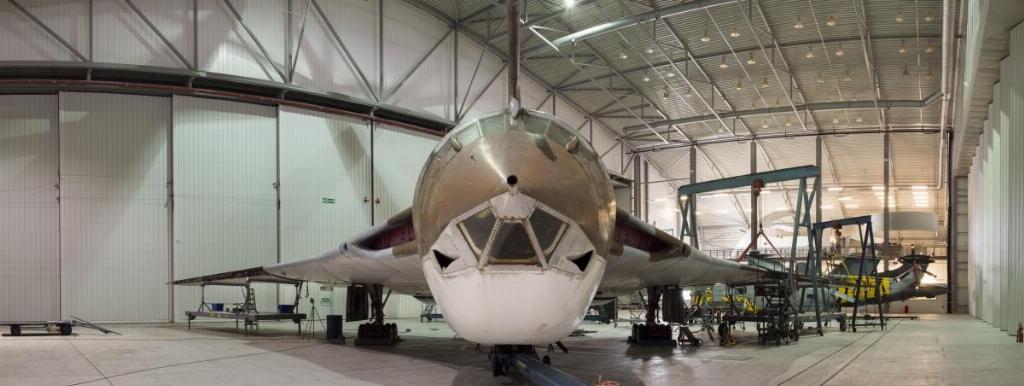Taking restoration in hand

The Imperial War Museum Duxford has been using a Niton handheld X-Ray fluorescence analyser while restoring an iconic V-bomber which saw service at the height of the cold war.
space Manufacturing finds out more.

While we may recoil from the horror inflicted by air force bombers, we can also celebrate the technological achievement and defence of democracy that they represent.
The Handley Page Victor bomber was one of the RAF’s celebrated V-Bomber fleet, which also included the Valiant and Vulcan, introduced in the 1950s as part of the United Kingdom’s strategic nuclear arsenal to counter the threat at that time from the USSR.
The bomber had a top speed of more than 600mph and a range of 6,000 miles, powered by four Armstrong Siddeley Sapphire turbojet engines and later Rolls-Royce Conway turbofans.
After their nuclear deterrent days were over many Victor bombers were converted to long range aerial refuelling tankers, finally being retired from military service in 1993.
The Imperial War Museum Duxford has had a Handley Page Victor bomber (XH648) in its collection for many years. The aircraft flew its first sortie in 1959 and in 1960 – with upgraded countermeasure electronics, radar and engines – it was dispatched on active service to No 15 squadron in the Far East. It saw action during proxy war incursions in Indonesia in 1962-63. Two years later the XH648 bomber returned to RAF Honington where refuelling pods were fitted under each wing, and it spent the next ten years serving as a fuel tanker, finally being sent to Imperial War Museum Duxford in 1976.

Curators at the museum are now restoring this historic aircraft to help future generations learn about the technology, politics, horror and excitement of air warfare in the mid-20th century. Last year the museum bought a Niton XL3T 955 handheld XRF analyser to screen artefacts, parts and materials for hazardous elements such as lead in paint and solder and arsenic in preservatives.
The curators and other museum employees, not to mention visitors, must be protected from these hazardous materials. However, during a restoration project involving the Victor XH648, the Niton analyser has also been used to identify the alloys from which the aircraft was built. If restorers pick the same or a similar alloy to repair a corroded part they can avoid causing more damage. Additionally, knowing precisely which material was used to build an aircraft component not only ensures the safety of curators and visitors, but also helps museum staff determine the provenance and improve how well they can tell the story of the aircraft.
Following the movement of the Victor into the Conservation in Action hangar at Duxford, detailed conservation work commenced on the aircraft. The bomb bay doors revealed some corrosion as did the elevator skins and drag chute doors which were all cleaned and treated for corrosion.
The project also involved removing the rudder and horizontal stabiliser and the outer wing leading edge sections which were dismantled in order to treat the badly corroded magnesium ribs. These were then treated and reassembled with some fabrication of new parts. Additionally, the aileron fixed trim tab was remanufactured due to extensive corrosion of the magnesium skin and new trim tab fittings were manufactured due to extensive corrosion. Conservation has continued on the outer wing leading edge sections and the ailerons.
Analyse and detect
Today’s aerospace manufacturers have similar material detection and safety concerns. As more varied advanced metals, non-metals and composites are used in modern aircraft handheld analysers can verify materials accurately, rapidly, avoid mistakes and prevent product failure.
Each year around 500 aircraft around the world are scrapped and disassembled. To be able to reuse and recycle some of these parts and materials, the alloys must be identified precisely. Handheld analysers are ideal to help aircraft breakers recycle at end of life. Some parts and materials may even end up being used in a restoration project at the Duxford museum.
Furthermore, as employers are required to protect their workforce from exposure to hazardous substances, handheld analysers can help companies comply with tighter health and safety regulations.
In effect a handheld instrument allows the user to take the laboratory to the work area whether it be on the shopfloor, in the hangar or out on the airfield. For example, the Niton XL3T 955 detects titanium down to 10 parts per million (ppm) and magnesium down to 750ppm. This high accuracy and precision is due to its large area silicon drift detector.
All Niton UK analysers use spectroscopy to identify the elements which make up materials. X-Rays or laser light is aimed at the material, whose atoms emit a characteristic spectral fingerprint.

In the UK, Niton UK is a leader in handheld X-Ray Fluorescence (XRF) instruments for manufacturing, recycling, identifying ores and verifying precious metals. Since 1999 the company has represented and serviced Thermo Scientific Niton XRF analysers and TSI PolyMax and ChemLite Laser analysers. There are now nearly 3,000 Niton XRF, Raman and LIBS instruments verifying materials and detecting contaminants in the field.
The Niton and ChemLite instruments analyse metals and alloys, while the PolyMax analyses plastics. Niton UK is the only ISO registered company supplying such products in the UK. Collectively, the staff at the company has more than 200 years of experience in metallurgy and materials analysis. It has a large client base throughout the UK and Ireland with instruments testing alloys and polymers in the aerospace, automotive, petrochemical, medical, mining and recycling industries.
Heightened security
Since 9/11 and the increase in levels of security threats worldwide, the demand for accurate handheld materials analysis in the field has increased dramatically. This has led to huge leaps forward in the technology and capability of handheld in situ spectroscopy.
A spin-off from detecting hazardous chemical threats is the use of handheld analysers for positive materials identification (PMI) to verify specialist alloys in aircraft parts. As aerospace engineering advanced rapidly throughout the 20th century, a wide range of stronger, lighter alloys were developed for building aircraft. In historic aircraft such as the Victor bomber these materials must be identified accurately so that corroded bomb bay doors can be fixed and magnesium wing ribs replaced, for example.
Many industries and research disciplines find fast, accurate, handheld spectroscopy essential to their activities. Niton analysers are also used by engineers to maintain pipework on oil rigs, build aircraft, prospect for ores, by jewellers to verify un-hallmarked gold and by scrap dealers to recycle alloys. They are also used to date works of art and identify alloys in racing car chassis.
In the case of the Victor bomber and its kind, these aircraft are firmly embedded in our culture and history. Niton instruments are helping to maintain and contribute to that story for future generations.
To learn more about the Imperial War Museum Duxford visit www.iwm.org.uk












